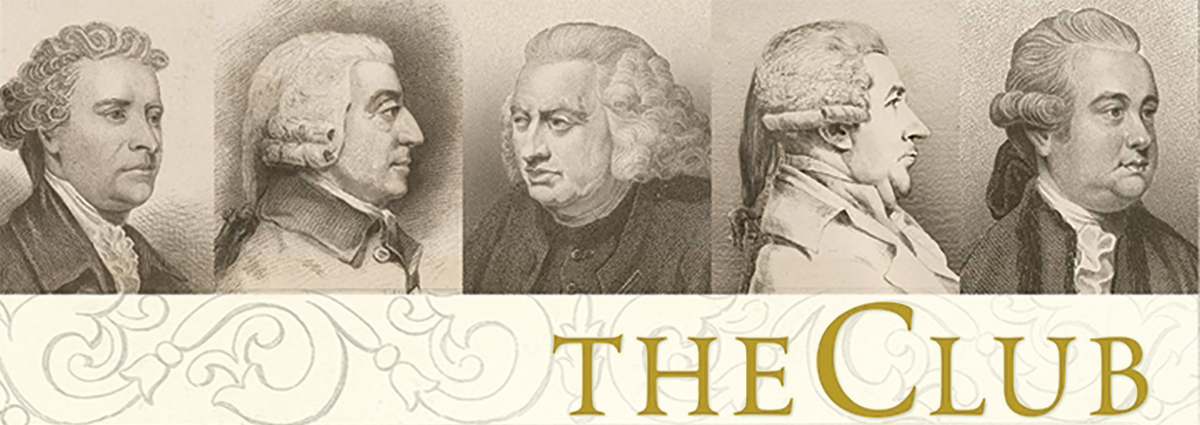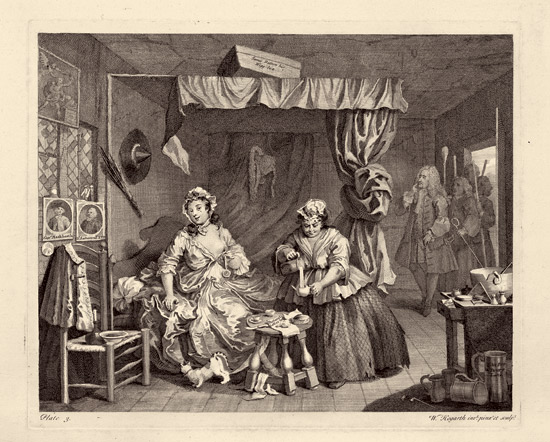If you had your druthers (and you were a white man) where would would you choose to hang out on a Friday evening in the late 18th century?
The Turk's Head Tavern, a venerable London establishment located at 9 Gerrard Street-- just off the Strand-- would be a good choice.
This is where-- starting in 1764-- intellectual and artistic notables such as Samuel Johnson, James Boswell, Edmund Burke, David Garrick, Edward Gibbon and Adam Smith met regularly. Quite a crew.
Leo Damrosch describes this era in his tour-de-force book the Club: Johnson, Boswell, and the Friends Who Shaped an Age. He also includes a group excluded from club membership, but constantly present in these lives: the women.
Especially the prostitutes.
Boswell frequented a lot of prostitutes. And he recorded the encounters in his journal, which his wife would sometimes inadvertently stumble upon and read. He had a very forgiving wife.
Boswell is the author of Life of Johnson, which is considered to be one of the greatest biographies ever written. A game-changer. It is a highly entertaining book. Boswell is Dr. Johnson's drunken sidekick and records everything that the great man says and does. But there's much more to this pair than meets the eye.

Damrosch thinks Boswell may have been bipolar. His mood swings are wild. He often self-medicates with copious amounts of alcohol and "promiscuous concubinage." Dr. Johnson exhibits symptoms of OCD, depression, and rheumatoid arthritis-- which leads him to become an opium addict later in life.
This is one of those books that I started thinking full well I wouldn't finish. But I made it all the way through, mainly because of Boswell's misadventures. Stuff like this:
Boswell seldom frequented the brothels around Covent Gardens. His usual practice was to rush out into the night after having plenty to drink, pick up a streetwalker, and grapple with her briefly in one of the parks or some dark alley. he may have enjoyed the sense of risk.
Boswell really struggled with his inveterate transgressions. He wanted to believe "in an authentic core of self," but David Hume's Treatise on Human Nature taught him otherwise. Boswell was happiest just going with the flow of impressions and perceptions of the moment, which made him such an amiable companion (but often a buffoon). Boswell's biographer insists that he wasn't a full-blown alcoholic-- because he could abstain from alcohol for long periods of time (as did other members of The Club . . . overindulgence and sobriety seem to be a pattern that has been around for a long time). But there are a lot of blackout injurious episodes that sound like they happened at a fraternity party.
After consuming five bottles of claret with just one companion, "I walked off very gravely, though much intoxicated. Ranged through the streets till, having run hard down the Advocate's Close, which is very steep, I found myself sudden bouncing down an almost perpendicular stone stair. I could not stop,but when I came to the bottom of it fell with a good deal of violence, which sobered me much." A later fall damaged his ankle so badly he was hobbling around for months.
Boswell is constantly swinging between intellectual pursuits-- the law, writing, and pondering free will and determinism, and concupiscent and inebriated episodes, such as getting caught by his wife while fondling a "fresh, plump, and comely" fifteen-year-old.
While Johnson and Boswell are at the heart of the book, I really liked Damrosch's portrayals of David Garrick and Edward Gibbon. Garrick was the greatest actor of the age, and he perfects a naturalistic style that was quite different from the typical strutting and speechifying player of the time. "He could make every thought and gesture seem perfectly spontaneous." This sort of acting was appreciated by the critics, but out in the country, "naturalistic acting would strike provincial audiences as no acting at all. Garrick is also remembered for organizing the Shakespeare Jubilee of 1769, which put Stafford-upon-Avon on the map and demarcated when Shakespeare went from being a competent playwright to a god. It also rained so much that Damrosch's description of the event smacks of a festival that happened two hundred years later: Woodstock.
For all their curiosity and intellect, Johnson and Boswell were men of their time. Johnson could often be religiously and politically conservative. His take on the American settlers was: "They are a race of convicts, and ought to be thankful for anything we allow them short of hanging." Oddly, Johnson sympathized with the Native Americans more than the colonials (though he didn't think the colonists should give them their land back). He felt the same about the Irish, and Irish rights. Rebellion was to be punished severely, he explained to Irish clergyman Thomas Campbell. When they had the chance, the British should have burned the Irish cities and "roasted you in the flames of them."
Boswell wrote a weird poem extolling slavery, in which he surmises at the end "For slavery there must ever be, while we have mistresses like thee!" And both Boswell and Johnson loathed Edward Gibbon, who wrote the classic historical treatise History of the Decline and Fall of the Roman Empire. They found this work scandalous because Gibbon was skeptical about the spread of Christianity due to miraculous events. Gibbon argued that there were plenty of "secular explanations" for Christian promulgation. Boswell and Johnson referred to Gibbon as "The Infidel." This is too bad, because Gibbon changed how history was written in the same way that Boswell changed how biography was written. They laid bare the sources and the journey to knowledge, the personal references and ambiguity that accompany all non-fiction writing, which many authors tried to hide under the guise of omniscience.

Damrosch's tour of the times is accompanied by many historical pictures. There are color plates in the center and various drawings, caricatures, portraits, and sketches throughout. This helps set the scene so much. The book alternates between great doings and anecdotes, so you get compelling portraits of men who are certainly great, but also flawed and silly (at one point, there is a description of Dr. Johnson imitating a kangaroo). And this is the same time as the framers were writing the Constitution. King George III actually makes a brief cameo. So it's a great view of what was happening on the other side of the ocean, as we were preparing to rebel. And there are a lot of prostitutes. What's not to enjoy?



2 comments:
This is why they call it a Johnson.
a joke from the 18th century, from the book:
"why is a fat man like a Cornish borough?"
"because he never sees his member"
good material for back then . . .
Post a Comment